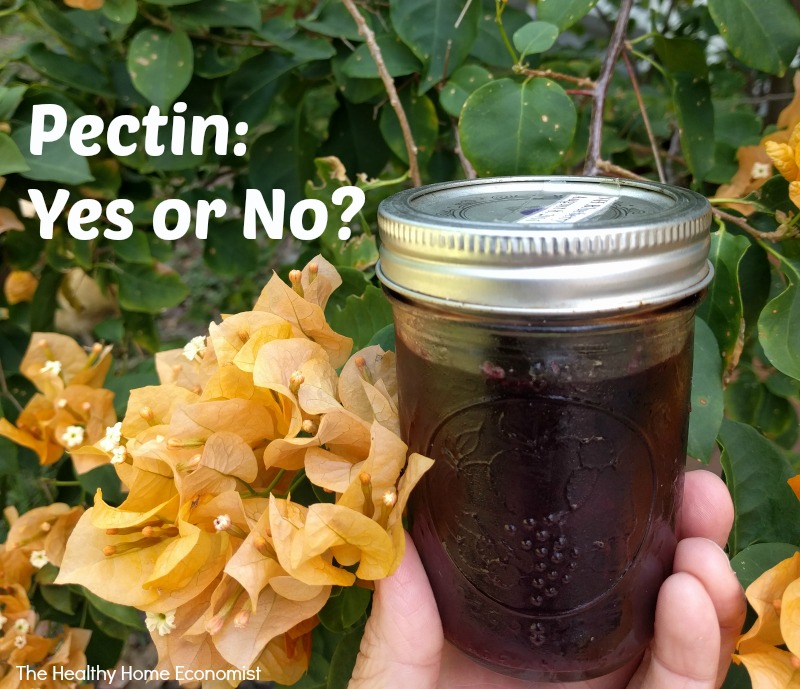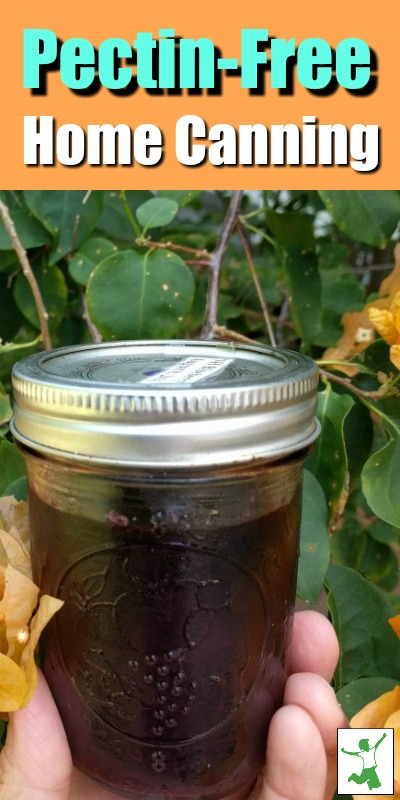Table of Contents[Hide][Show]

Pectin is an almost universal additive to commercially made jams and jellies. Even when homemade, this ingredient is commonly used to ensure a consistently gelled end result.
What many homemade jam and jelly enthusiasts don’t realize, however, is that pectin is not a desirable ingredient and should be avoided when an optimally healthy condiment is the goal.
The reasons are threefold.
Commercial Pectin
First, pectin can be made from corn and that usually means genetically modified corn unless the product is certified organic.
Even “all-natural” fruit versions are typically GMO based as they contain dextrose and citric acid, both corn-derived products. For example, take a look at the ingredients of Sure-Jell, a popular brand used by home canners:
Sure-Jell Ingredients: Dextrose, citric acid, fruit pectin.
While the fruit pectin itself isn’t a problem, the GMO dextrose and citric acid most definitely are.
Fruit Pectin Means High Sugar
Another reason to avoid commercial pectin is the amount of sugar that is required for it to work properly.
In order for commercial pectin to set, 55-85% of the jam or jelly must be sugar. This means that your homemade creation would contain more sugar than fruit!
Not exactly the type of spread you want your children using for breakfast toast before school for optimal learning and concentration.
Avoid Even Low Sugar Brands
What about low sugar versions, you may ask? This type of pectin binds with calcium instead of sugar to set properly and would allow the home canner to use much less sugar, no sugar, or a bit of stevia instead.
Low sugar pectins have the same problem as regular pectin in that they typically contain GMO ingredients. Here are the ingredients of low sugar Sure-Jell: (GMO corn) dextrose, fruit pectin, fumaric acid, sodium citrate.
While a low sugar brand like Pomona’s Universal Pectin uses only 100% citrus-derived ingredients, it, unfortunately, isn’t an organic product. Citrus trees are a highly sprayed crop with all manner of pesticides including a class of pesticides called cholinesterase inhibitors, known to be highly toxic to the nervous system. When citrus fruits arrive at the factory, the entire fruit is placed into the machines doing the processing – pesticides and all!
In addition, acid sprays are used to ensure that every drop of juice is extracted including the oil from the skin. These toxic residues (not listed on the ingredient label) are served up not just with commercial citrus juices, but additional products made with them such as citrus pectin.
Another lesser problem is that if you have hard water with high calcium content this may cause the jam to get overly firm, even rubbery.
Added Pectin?
Home canners, don’t despair! You don’t really need added pectin when making your favorite jam and jelly recipes.
The trick is to use fruit that is naturally high in pectin such as:
- Most apples
- Grapes
- Most berries
- Crabapples
- Currants
- Lemons
- Plums
- Raspberries
When making jam without added pectin, be sure to use fully ripe fruit only. Wash the fruit before cooking but do not soak. Remove stems, skins, and pits before cutting into pieces.
For jelly made without added pectin, select a mix of 3/4 ripe and 1/4 under-ripe fruit. Do not use commercially canned or frozen fruit juice as the pectin is too low. Crush soft, fully ripe fruits or berries and cut the firmer, under-ripe fruit into small pieces. Use the fruit peels and cores during cooking as this will add additional pectin.

Make Your Own!
If you feel that you really need to use pectin in your home canning efforts to ensure consistent results for the time spent, it is best to make your own to ensure a quality, GMO-free, pesticide-free product.
Here’s are the steps in a nutshell:
- Wash, but don’t peel about seven large tart ORGANIC apples. Granny Smith or crabapples work well.
- Cut the apples into pieces and add four cups of water and two tablespoons of organic lemon juice (fresh squeezed is ideal as it is higher in pectin than store-bought).
- Boil the mixture for 40 minutes, then strain it through an unbleached cheesecloth.
- Boil the juice for another 20 minutes, pour it into sterilized jars and seal.
- To test the pectin content of the concentrated juice, stir one tablespoon of grain or wood alcohol into one teaspoon of fruit juice. DO NOT TASTE! Juices that are high in natural pectin will form a lot of chunky gel. Those with an average pectin content will form a few pieces of the jelly-like substance. Low pectin juice that is low in pectin content will form only small, flaky pieces of sediment.
Knowing the pectin content of the final product will help you judge how much pectin to add to your homemade jam and jelly recipes which will vary with each batch of homemade pectin you produce.
Happy canning!
References
(1) Canning, Pickling and Freezing with Irma Harding
(2) Your Own Pectin Recipe
(3) Comparison of Low Sugar vs Traditional Pectin Recipe
More Information
How to Make Orangina








Thank you! This is perfect timing as berry season is upon us! Trying to renew my canning and food preservation skills from many years ago.
Yes what is the shelf life of I suppose it’s canned pectin?
I appreciate your pointing out the disadvantages of using Pomona’s pectin powder. Unfortunately, I want to make a non-dairy hemp yogurt, and the recipe calls for the pectin powder as a necessary requirement for thickening. So, it appears now I’m left with no options.
How long does it last without being damaged in a regular glass container without sealing and how much in a sealed and sterilized container ??? Thank you